Strategic Management Assessment: Analyzing Sainsbury's Performance
VerifiedAdded on 2023/01/18
|11
|3761
|23
Report
AI Summary
This report provides a comprehensive strategic analysis of Sainsbury's, a major UK supermarket chain. It begins with an executive summary outlining the objectives and methodologies employed. The main body of the report focuses on applying PESTLE and Porter's Five Forces models to assess Sainsbury's external environment and competitive landscape. The PESTLE analysis examines political, economic, social, technological, legal, and environmental factors influencing Sainsbury's operations, particularly focusing on the impact of Brexit, economic fluctuations, changing consumer preferences, technological advancements, and environmental concerns. The Porter's Five Forces model assesses the competitive intensity within the grocery market, including the threat of new entrants, the bargaining power of suppliers and buyers, the threat of substitutes, and the intensity of rivalry among existing competitors. The report concludes with recommendations aimed at improving Sainsbury's overall productivity and profitability. The analysis considers Sainsbury's challenges in adapting to evolving consumer trends and maintaining its competitive edge in the face of rivals like Asda and Aldi. The report highlights the importance of strategic management in guiding organizations toward their goals and achieving sustainable success in a dynamic market.
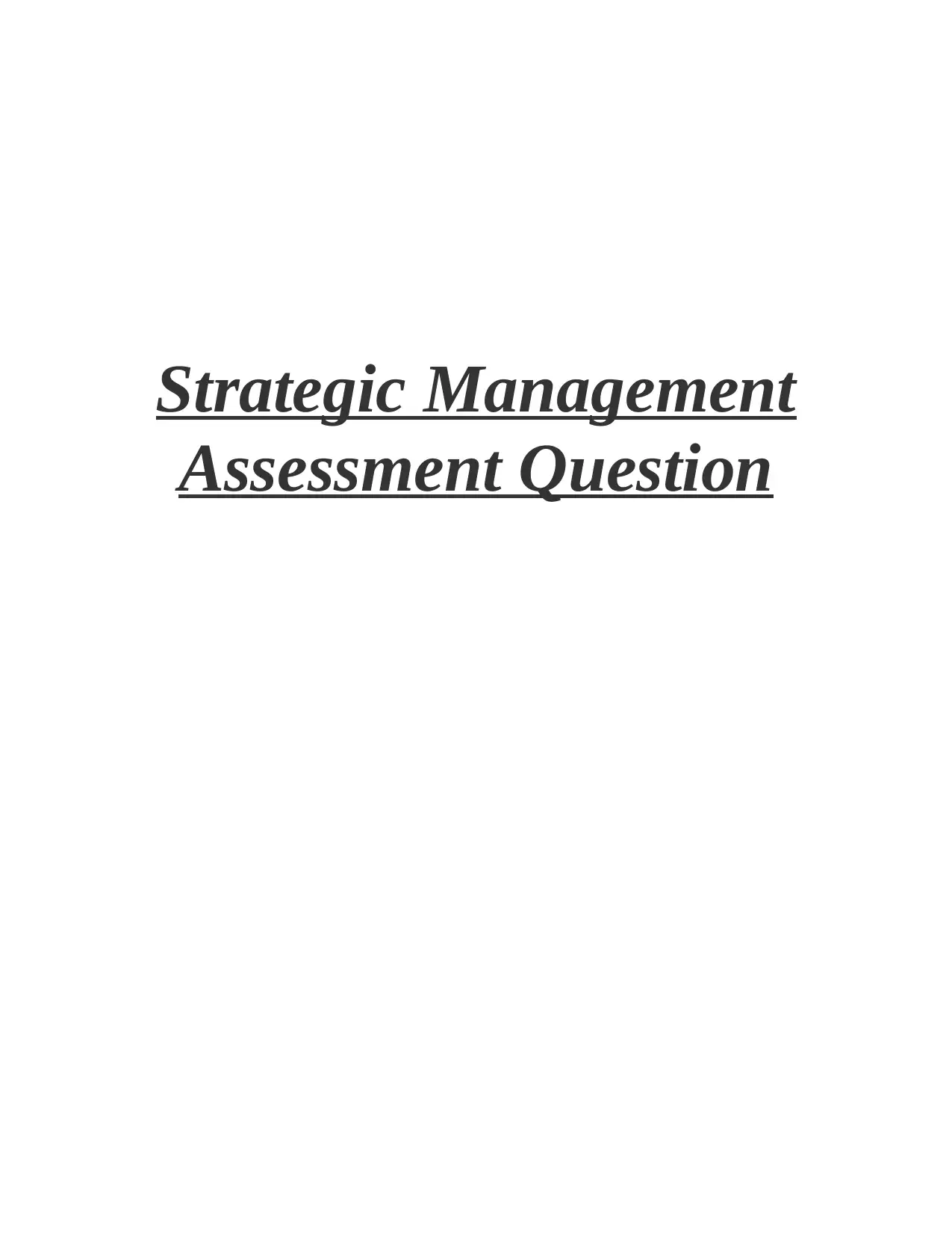
Strategic Management
Assessment Question
Assessment Question
Paraphrase This Document
Need a fresh take? Get an instant paraphrase of this document with our AI Paraphraser
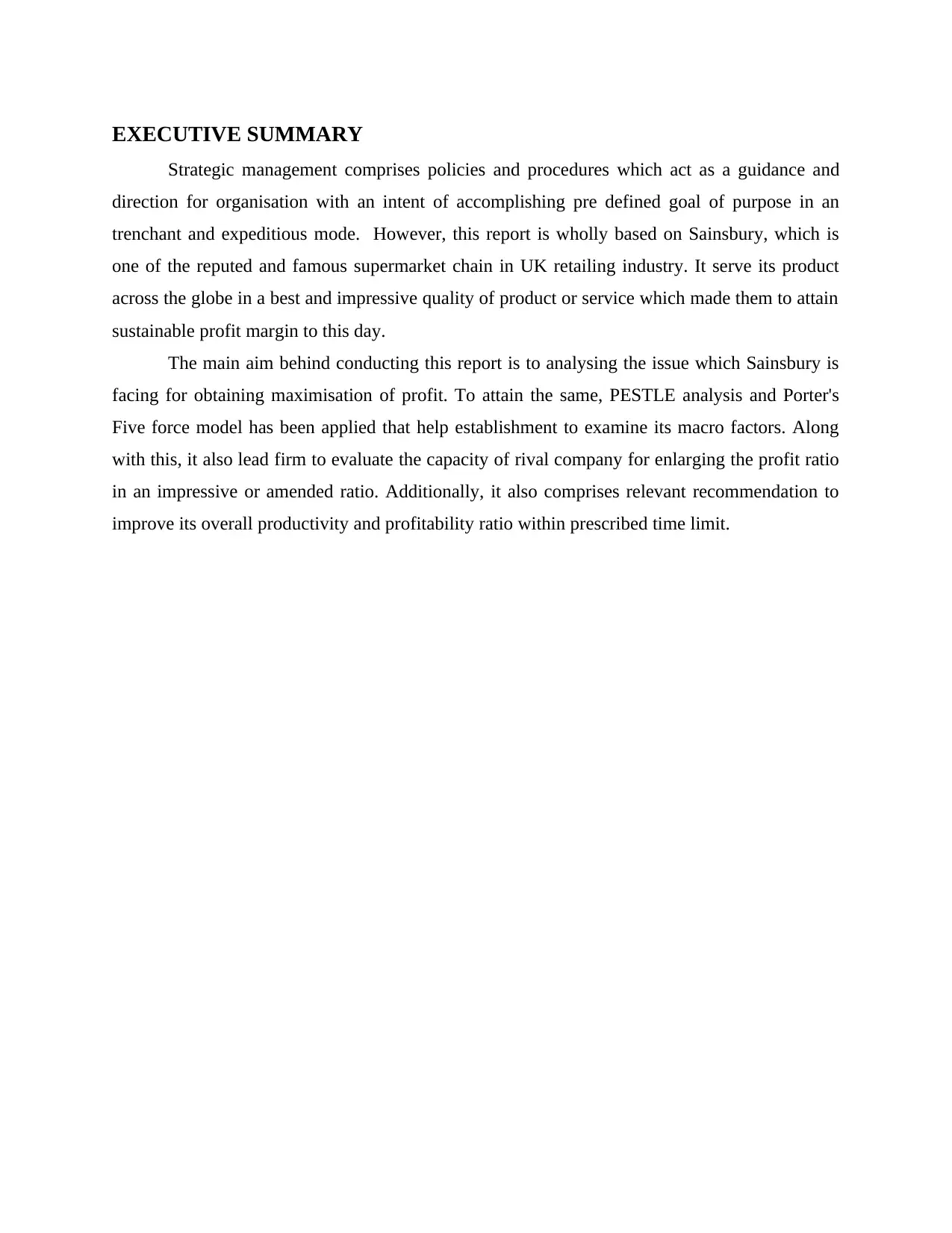
EXECUTIVE SUMMARY
Strategic management comprises policies and procedures which act as a guidance and
direction for organisation with an intent of accomplishing pre defined goal of purpose in an
trenchant and expeditious mode. However, this report is wholly based on Sainsbury, which is
one of the reputed and famous supermarket chain in UK retailing industry. It serve its product
across the globe in a best and impressive quality of product or service which made them to attain
sustainable profit margin to this day.
The main aim behind conducting this report is to analysing the issue which Sainsbury is
facing for obtaining maximisation of profit. To attain the same, PESTLE analysis and Porter's
Five force model has been applied that help establishment to examine its macro factors. Along
with this, it also lead firm to evaluate the capacity of rival company for enlarging the profit ratio
in an impressive or amended ratio. Additionally, it also comprises relevant recommendation to
improve its overall productivity and profitability ratio within prescribed time limit.
Strategic management comprises policies and procedures which act as a guidance and
direction for organisation with an intent of accomplishing pre defined goal of purpose in an
trenchant and expeditious mode. However, this report is wholly based on Sainsbury, which is
one of the reputed and famous supermarket chain in UK retailing industry. It serve its product
across the globe in a best and impressive quality of product or service which made them to attain
sustainable profit margin to this day.
The main aim behind conducting this report is to analysing the issue which Sainsbury is
facing for obtaining maximisation of profit. To attain the same, PESTLE analysis and Porter's
Five force model has been applied that help establishment to examine its macro factors. Along
with this, it also lead firm to evaluate the capacity of rival company for enlarging the profit ratio
in an impressive or amended ratio. Additionally, it also comprises relevant recommendation to
improve its overall productivity and profitability ratio within prescribed time limit.
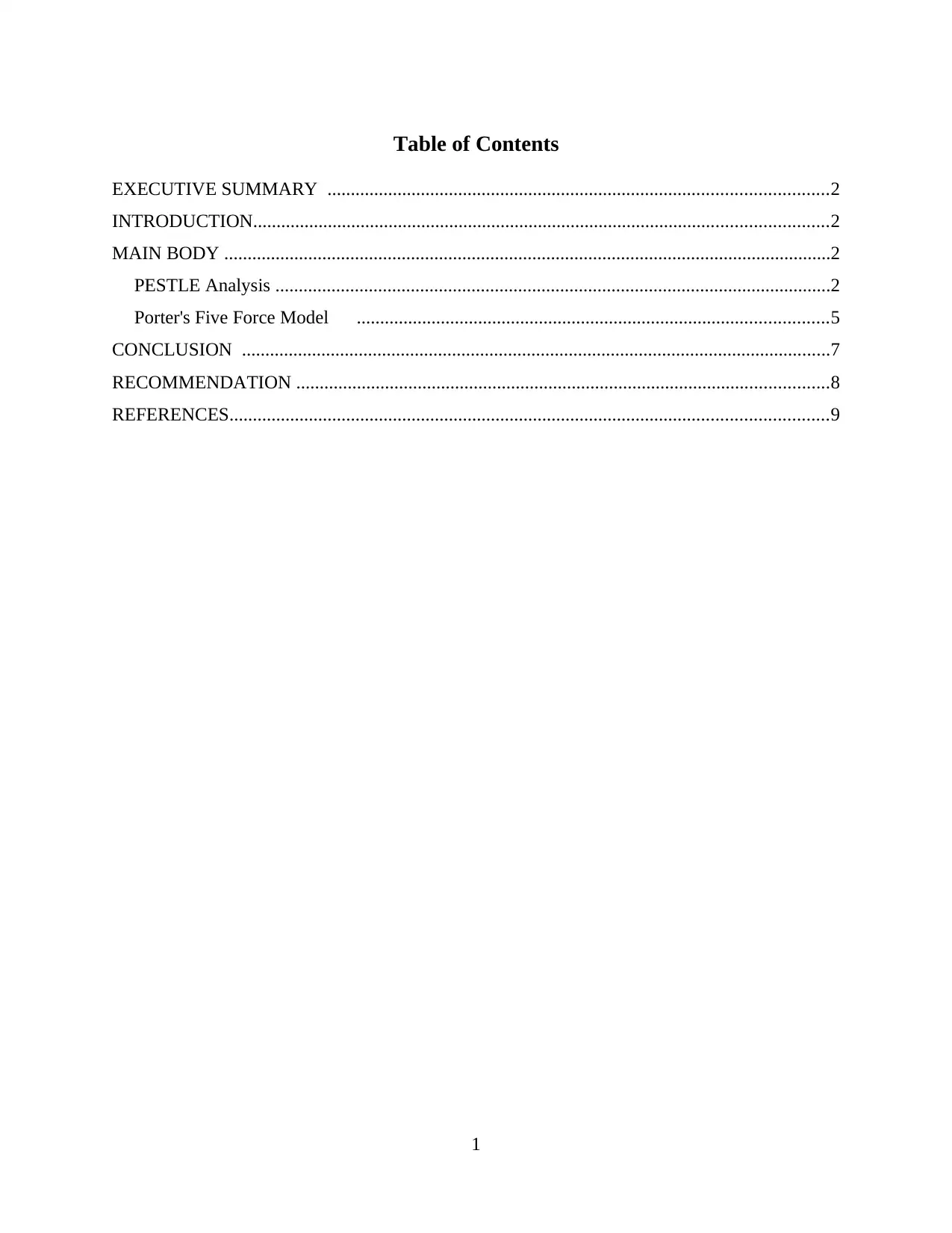
Table of Contents
EXECUTIVE SUMMARY ...........................................................................................................2
INTRODUCTION...........................................................................................................................2
MAIN BODY ..................................................................................................................................2
PESTLE Analysis .......................................................................................................................2
Porter's Five Force Model .....................................................................................................5
CONCLUSION ..............................................................................................................................7
RECOMMENDATION ..................................................................................................................8
REFERENCES................................................................................................................................9
1
EXECUTIVE SUMMARY ...........................................................................................................2
INTRODUCTION...........................................................................................................................2
MAIN BODY ..................................................................................................................................2
PESTLE Analysis .......................................................................................................................2
Porter's Five Force Model .....................................................................................................5
CONCLUSION ..............................................................................................................................7
RECOMMENDATION ..................................................................................................................8
REFERENCES................................................................................................................................9
1
⊘ This is a preview!⊘
Do you want full access?
Subscribe today to unlock all pages.

Trusted by 1+ million students worldwide
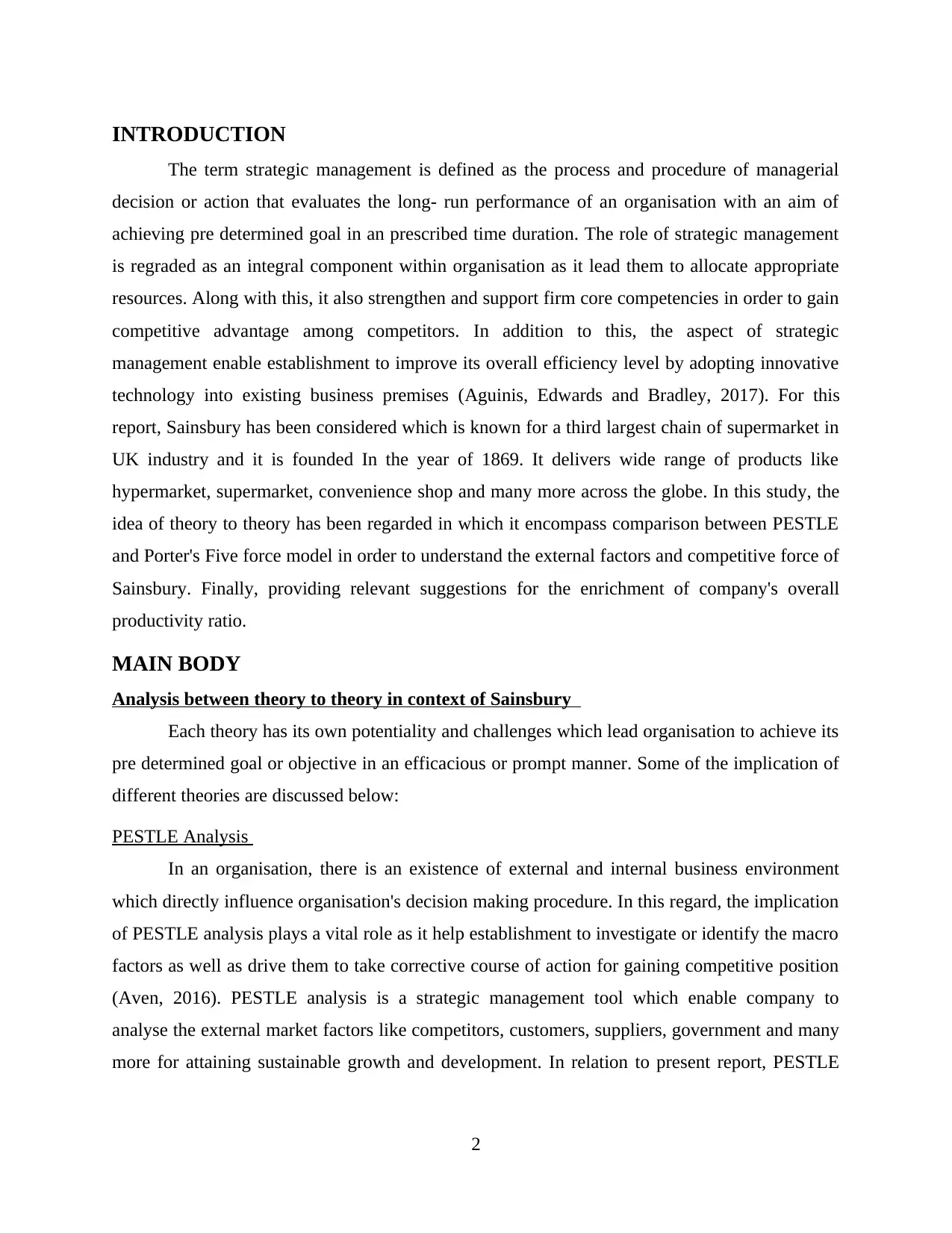
INTRODUCTION
The term strategic management is defined as the process and procedure of managerial
decision or action that evaluates the long- run performance of an organisation with an aim of
achieving pre determined goal in an prescribed time duration. The role of strategic management
is regraded as an integral component within organisation as it lead them to allocate appropriate
resources. Along with this, it also strengthen and support firm core competencies in order to gain
competitive advantage among competitors. In addition to this, the aspect of strategic
management enable establishment to improve its overall efficiency level by adopting innovative
technology into existing business premises (Aguinis, Edwards and Bradley, 2017). For this
report, Sainsbury has been considered which is known for a third largest chain of supermarket in
UK industry and it is founded In the year of 1869. It delivers wide range of products like
hypermarket, supermarket, convenience shop and many more across the globe. In this study, the
idea of theory to theory has been regarded in which it encompass comparison between PESTLE
and Porter's Five force model in order to understand the external factors and competitive force of
Sainsbury. Finally, providing relevant suggestions for the enrichment of company's overall
productivity ratio.
MAIN BODY
Analysis between theory to theory in context of Sainsbury
Each theory has its own potentiality and challenges which lead organisation to achieve its
pre determined goal or objective in an efficacious or prompt manner. Some of the implication of
different theories are discussed below:
PESTLE Analysis
In an organisation, there is an existence of external and internal business environment
which directly influence organisation's decision making procedure. In this regard, the implication
of PESTLE analysis plays a vital role as it help establishment to investigate or identify the macro
factors as well as drive them to take corrective course of action for gaining competitive position
(Aven, 2016). PESTLE analysis is a strategic management tool which enable company to
analyse the external market factors like competitors, customers, suppliers, government and many
more for attaining sustainable growth and development. In relation to present report, PESTLE
2
The term strategic management is defined as the process and procedure of managerial
decision or action that evaluates the long- run performance of an organisation with an aim of
achieving pre determined goal in an prescribed time duration. The role of strategic management
is regraded as an integral component within organisation as it lead them to allocate appropriate
resources. Along with this, it also strengthen and support firm core competencies in order to gain
competitive advantage among competitors. In addition to this, the aspect of strategic
management enable establishment to improve its overall efficiency level by adopting innovative
technology into existing business premises (Aguinis, Edwards and Bradley, 2017). For this
report, Sainsbury has been considered which is known for a third largest chain of supermarket in
UK industry and it is founded In the year of 1869. It delivers wide range of products like
hypermarket, supermarket, convenience shop and many more across the globe. In this study, the
idea of theory to theory has been regarded in which it encompass comparison between PESTLE
and Porter's Five force model in order to understand the external factors and competitive force of
Sainsbury. Finally, providing relevant suggestions for the enrichment of company's overall
productivity ratio.
MAIN BODY
Analysis between theory to theory in context of Sainsbury
Each theory has its own potentiality and challenges which lead organisation to achieve its
pre determined goal or objective in an efficacious or prompt manner. Some of the implication of
different theories are discussed below:
PESTLE Analysis
In an organisation, there is an existence of external and internal business environment
which directly influence organisation's decision making procedure. In this regard, the implication
of PESTLE analysis plays a vital role as it help establishment to investigate or identify the macro
factors as well as drive them to take corrective course of action for gaining competitive position
(Aven, 2016). PESTLE analysis is a strategic management tool which enable company to
analyse the external market factors like competitors, customers, suppliers, government and many
more for attaining sustainable growth and development. In relation to present report, PESTLE
2
Paraphrase This Document
Need a fresh take? Get an instant paraphrase of this document with our AI Paraphraser
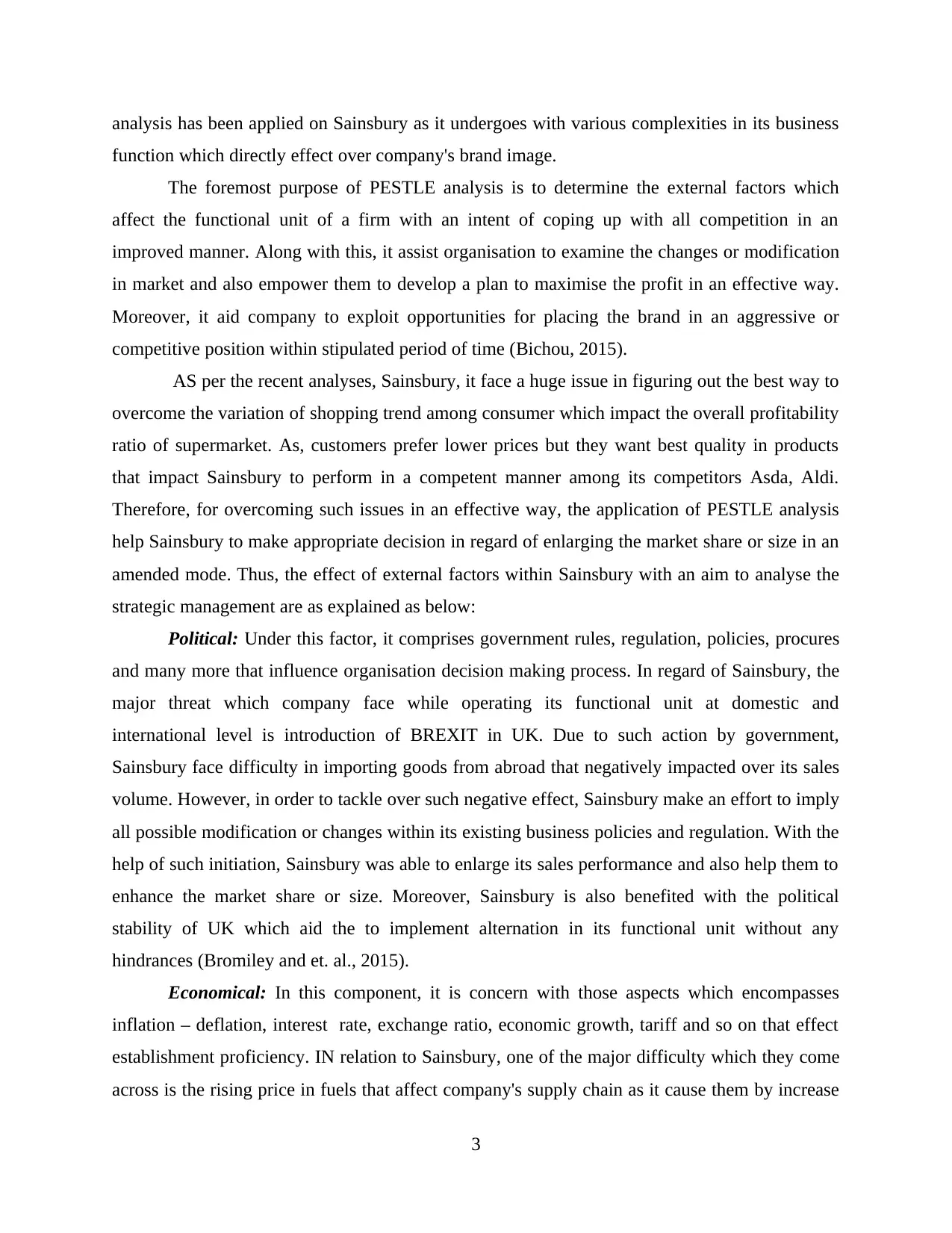
analysis has been applied on Sainsbury as it undergoes with various complexities in its business
function which directly effect over company's brand image.
The foremost purpose of PESTLE analysis is to determine the external factors which
affect the functional unit of a firm with an intent of coping up with all competition in an
improved manner. Along with this, it assist organisation to examine the changes or modification
in market and also empower them to develop a plan to maximise the profit in an effective way.
Moreover, it aid company to exploit opportunities for placing the brand in an aggressive or
competitive position within stipulated period of time (Bichou, 2015).
AS per the recent analyses, Sainsbury, it face a huge issue in figuring out the best way to
overcome the variation of shopping trend among consumer which impact the overall profitability
ratio of supermarket. As, customers prefer lower prices but they want best quality in products
that impact Sainsbury to perform in a competent manner among its competitors Asda, Aldi.
Therefore, for overcoming such issues in an effective way, the application of PESTLE analysis
help Sainsbury to make appropriate decision in regard of enlarging the market share or size in an
amended mode. Thus, the effect of external factors within Sainsbury with an aim to analyse the
strategic management are as explained as below:
Political: Under this factor, it comprises government rules, regulation, policies, procures
and many more that influence organisation decision making process. In regard of Sainsbury, the
major threat which company face while operating its functional unit at domestic and
international level is introduction of BREXIT in UK. Due to such action by government,
Sainsbury face difficulty in importing goods from abroad that negatively impacted over its sales
volume. However, in order to tackle over such negative effect, Sainsbury make an effort to imply
all possible modification or changes within its existing business policies and regulation. With the
help of such initiation, Sainsbury was able to enlarge its sales performance and also help them to
enhance the market share or size. Moreover, Sainsbury is also benefited with the political
stability of UK which aid the to implement alternation in its functional unit without any
hindrances (Bromiley and et. al., 2015).
Economical: In this component, it is concern with those aspects which encompasses
inflation – deflation, interest rate, exchange ratio, economic growth, tariff and so on that effect
establishment proficiency. IN relation to Sainsbury, one of the major difficulty which they come
across is the rising price in fuels that affect company's supply chain as it cause them by increase
3
function which directly effect over company's brand image.
The foremost purpose of PESTLE analysis is to determine the external factors which
affect the functional unit of a firm with an intent of coping up with all competition in an
improved manner. Along with this, it assist organisation to examine the changes or modification
in market and also empower them to develop a plan to maximise the profit in an effective way.
Moreover, it aid company to exploit opportunities for placing the brand in an aggressive or
competitive position within stipulated period of time (Bichou, 2015).
AS per the recent analyses, Sainsbury, it face a huge issue in figuring out the best way to
overcome the variation of shopping trend among consumer which impact the overall profitability
ratio of supermarket. As, customers prefer lower prices but they want best quality in products
that impact Sainsbury to perform in a competent manner among its competitors Asda, Aldi.
Therefore, for overcoming such issues in an effective way, the application of PESTLE analysis
help Sainsbury to make appropriate decision in regard of enlarging the market share or size in an
amended mode. Thus, the effect of external factors within Sainsbury with an aim to analyse the
strategic management are as explained as below:
Political: Under this factor, it comprises government rules, regulation, policies, procures
and many more that influence organisation decision making process. In regard of Sainsbury, the
major threat which company face while operating its functional unit at domestic and
international level is introduction of BREXIT in UK. Due to such action by government,
Sainsbury face difficulty in importing goods from abroad that negatively impacted over its sales
volume. However, in order to tackle over such negative effect, Sainsbury make an effort to imply
all possible modification or changes within its existing business policies and regulation. With the
help of such initiation, Sainsbury was able to enlarge its sales performance and also help them to
enhance the market share or size. Moreover, Sainsbury is also benefited with the political
stability of UK which aid the to implement alternation in its functional unit without any
hindrances (Bromiley and et. al., 2015).
Economical: In this component, it is concern with those aspects which encompasses
inflation – deflation, interest rate, exchange ratio, economic growth, tariff and so on that effect
establishment proficiency. IN relation to Sainsbury, one of the major difficulty which they come
across is the rising price in fuels that affect company's supply chain as it cause them by increase
3
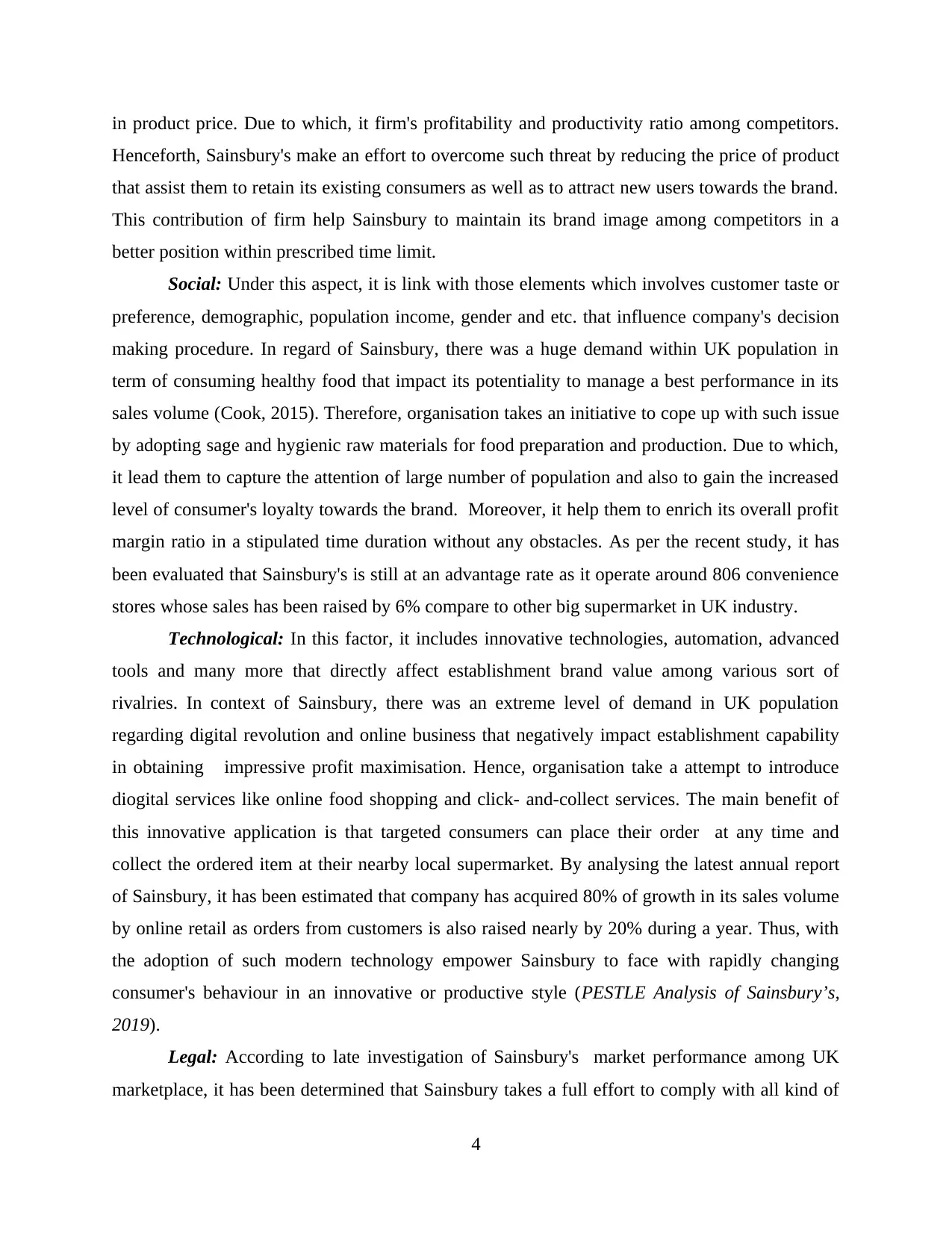
in product price. Due to which, it firm's profitability and productivity ratio among competitors.
Henceforth, Sainsbury's make an effort to overcome such threat by reducing the price of product
that assist them to retain its existing consumers as well as to attract new users towards the brand.
This contribution of firm help Sainsbury to maintain its brand image among competitors in a
better position within prescribed time limit.
Social: Under this aspect, it is link with those elements which involves customer taste or
preference, demographic, population income, gender and etc. that influence company's decision
making procedure. In regard of Sainsbury, there was a huge demand within UK population in
term of consuming healthy food that impact its potentiality to manage a best performance in its
sales volume (Cook, 2015). Therefore, organisation takes an initiative to cope up with such issue
by adopting sage and hygienic raw materials for food preparation and production. Due to which,
it lead them to capture the attention of large number of population and also to gain the increased
level of consumer's loyalty towards the brand. Moreover, it help them to enrich its overall profit
margin ratio in a stipulated time duration without any obstacles. As per the recent study, it has
been evaluated that Sainsbury's is still at an advantage rate as it operate around 806 convenience
stores whose sales has been raised by 6% compare to other big supermarket in UK industry.
Technological: In this factor, it includes innovative technologies, automation, advanced
tools and many more that directly affect establishment brand value among various sort of
rivalries. In context of Sainsbury, there was an extreme level of demand in UK population
regarding digital revolution and online business that negatively impact establishment capability
in obtaining impressive profit maximisation. Hence, organisation take a attempt to introduce
diogital services like online food shopping and click- and-collect services. The main benefit of
this innovative application is that targeted consumers can place their order at any time and
collect the ordered item at their nearby local supermarket. By analysing the latest annual report
of Sainsbury, it has been estimated that company has acquired 80% of growth in its sales volume
by online retail as orders from customers is also raised nearly by 20% during a year. Thus, with
the adoption of such modern technology empower Sainsbury to face with rapidly changing
consumer's behaviour in an innovative or productive style (PESTLE Analysis of Sainsbury’s,
2019).
Legal: According to late investigation of Sainsbury's market performance among UK
marketplace, it has been determined that Sainsbury takes a full effort to comply with all kind of
4
Henceforth, Sainsbury's make an effort to overcome such threat by reducing the price of product
that assist them to retain its existing consumers as well as to attract new users towards the brand.
This contribution of firm help Sainsbury to maintain its brand image among competitors in a
better position within prescribed time limit.
Social: Under this aspect, it is link with those elements which involves customer taste or
preference, demographic, population income, gender and etc. that influence company's decision
making procedure. In regard of Sainsbury, there was a huge demand within UK population in
term of consuming healthy food that impact its potentiality to manage a best performance in its
sales volume (Cook, 2015). Therefore, organisation takes an initiative to cope up with such issue
by adopting sage and hygienic raw materials for food preparation and production. Due to which,
it lead them to capture the attention of large number of population and also to gain the increased
level of consumer's loyalty towards the brand. Moreover, it help them to enrich its overall profit
margin ratio in a stipulated time duration without any obstacles. As per the recent study, it has
been evaluated that Sainsbury's is still at an advantage rate as it operate around 806 convenience
stores whose sales has been raised by 6% compare to other big supermarket in UK industry.
Technological: In this factor, it includes innovative technologies, automation, advanced
tools and many more that directly affect establishment brand value among various sort of
rivalries. In context of Sainsbury, there was an extreme level of demand in UK population
regarding digital revolution and online business that negatively impact establishment capability
in obtaining impressive profit maximisation. Hence, organisation take a attempt to introduce
diogital services like online food shopping and click- and-collect services. The main benefit of
this innovative application is that targeted consumers can place their order at any time and
collect the ordered item at their nearby local supermarket. By analysing the latest annual report
of Sainsbury, it has been estimated that company has acquired 80% of growth in its sales volume
by online retail as orders from customers is also raised nearly by 20% during a year. Thus, with
the adoption of such modern technology empower Sainsbury to face with rapidly changing
consumer's behaviour in an innovative or productive style (PESTLE Analysis of Sainsbury’s,
2019).
Legal: According to late investigation of Sainsbury's market performance among UK
marketplace, it has been determined that Sainsbury takes a full effort to comply with all kind of
4
⊘ This is a preview!⊘
Do you want full access?
Subscribe today to unlock all pages.

Trusted by 1+ million students worldwide
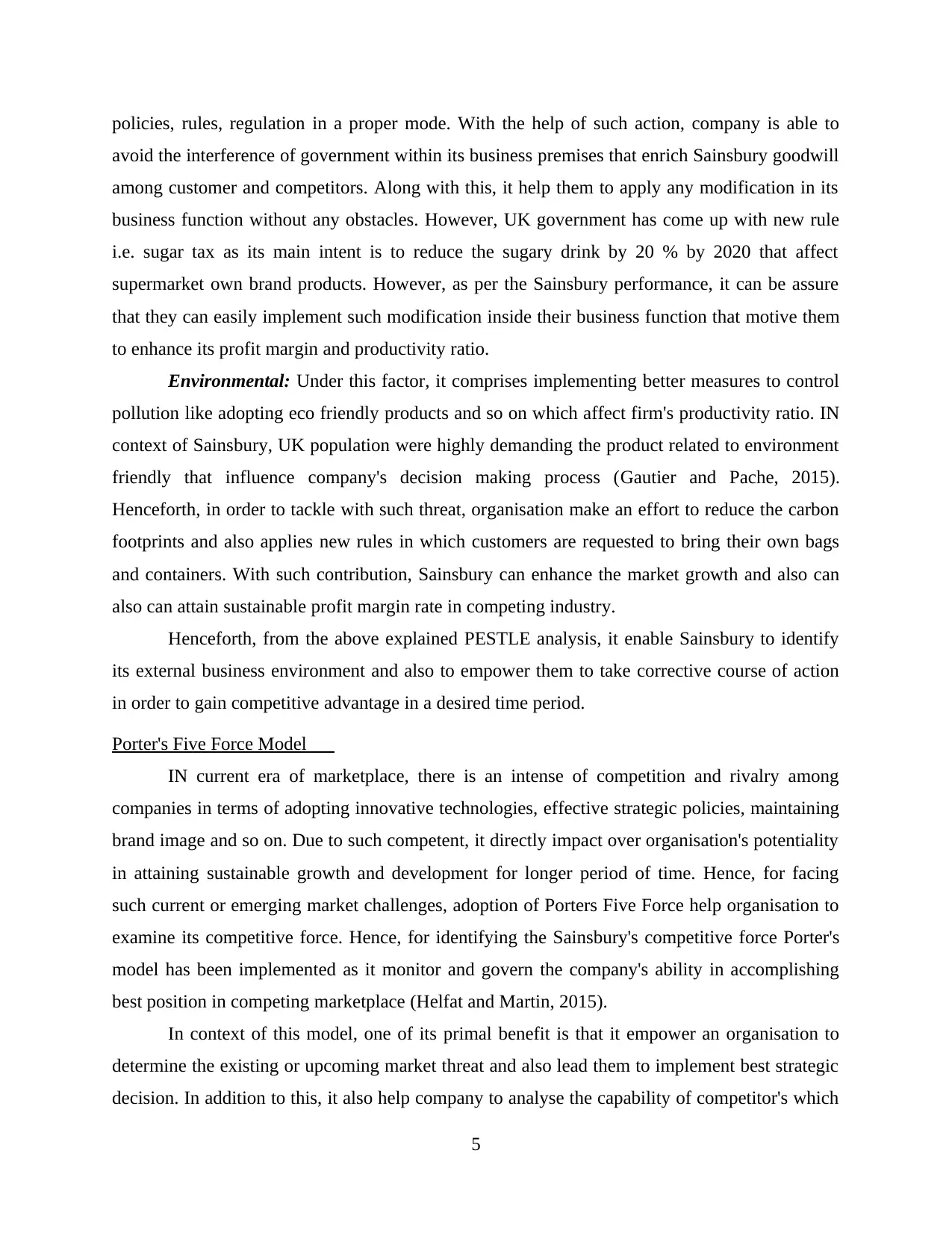
policies, rules, regulation in a proper mode. With the help of such action, company is able to
avoid the interference of government within its business premises that enrich Sainsbury goodwill
among customer and competitors. Along with this, it help them to apply any modification in its
business function without any obstacles. However, UK government has come up with new rule
i.e. sugar tax as its main intent is to reduce the sugary drink by 20 % by 2020 that affect
supermarket own brand products. However, as per the Sainsbury performance, it can be assure
that they can easily implement such modification inside their business function that motive them
to enhance its profit margin and productivity ratio.
Environmental: Under this factor, it comprises implementing better measures to control
pollution like adopting eco friendly products and so on which affect firm's productivity ratio. IN
context of Sainsbury, UK population were highly demanding the product related to environment
friendly that influence company's decision making process (Gautier and Pache, 2015).
Henceforth, in order to tackle with such threat, organisation make an effort to reduce the carbon
footprints and also applies new rules in which customers are requested to bring their own bags
and containers. With such contribution, Sainsbury can enhance the market growth and also can
also can attain sustainable profit margin rate in competing industry.
Henceforth, from the above explained PESTLE analysis, it enable Sainsbury to identify
its external business environment and also to empower them to take corrective course of action
in order to gain competitive advantage in a desired time period.
Porter's Five Force Model
IN current era of marketplace, there is an intense of competition and rivalry among
companies in terms of adopting innovative technologies, effective strategic policies, maintaining
brand image and so on. Due to such competent, it directly impact over organisation's potentiality
in attaining sustainable growth and development for longer period of time. Hence, for facing
such current or emerging market challenges, adoption of Porters Five Force help organisation to
examine its competitive force. Hence, for identifying the Sainsbury's competitive force Porter's
model has been implemented as it monitor and govern the company's ability in accomplishing
best position in competing marketplace (Helfat and Martin, 2015).
In context of this model, one of its primal benefit is that it empower an organisation to
determine the existing or upcoming market threat and also lead them to implement best strategic
decision. In addition to this, it also help company to analyse the capability of competitor's which
5
avoid the interference of government within its business premises that enrich Sainsbury goodwill
among customer and competitors. Along with this, it help them to apply any modification in its
business function without any obstacles. However, UK government has come up with new rule
i.e. sugar tax as its main intent is to reduce the sugary drink by 20 % by 2020 that affect
supermarket own brand products. However, as per the Sainsbury performance, it can be assure
that they can easily implement such modification inside their business function that motive them
to enhance its profit margin and productivity ratio.
Environmental: Under this factor, it comprises implementing better measures to control
pollution like adopting eco friendly products and so on which affect firm's productivity ratio. IN
context of Sainsbury, UK population were highly demanding the product related to environment
friendly that influence company's decision making process (Gautier and Pache, 2015).
Henceforth, in order to tackle with such threat, organisation make an effort to reduce the carbon
footprints and also applies new rules in which customers are requested to bring their own bags
and containers. With such contribution, Sainsbury can enhance the market growth and also can
also can attain sustainable profit margin rate in competing industry.
Henceforth, from the above explained PESTLE analysis, it enable Sainsbury to identify
its external business environment and also to empower them to take corrective course of action
in order to gain competitive advantage in a desired time period.
Porter's Five Force Model
IN current era of marketplace, there is an intense of competition and rivalry among
companies in terms of adopting innovative technologies, effective strategic policies, maintaining
brand image and so on. Due to such competent, it directly impact over organisation's potentiality
in attaining sustainable growth and development for longer period of time. Hence, for facing
such current or emerging market challenges, adoption of Porters Five Force help organisation to
examine its competitive force. Hence, for identifying the Sainsbury's competitive force Porter's
model has been implemented as it monitor and govern the company's ability in accomplishing
best position in competing marketplace (Helfat and Martin, 2015).
In context of this model, one of its primal benefit is that it empower an organisation to
determine the existing or upcoming market threat and also lead them to implement best strategic
decision. In addition to this, it also help company to analyse the capability of competitor's which
5
Paraphrase This Document
Need a fresh take? Get an instant paraphrase of this document with our AI Paraphraser
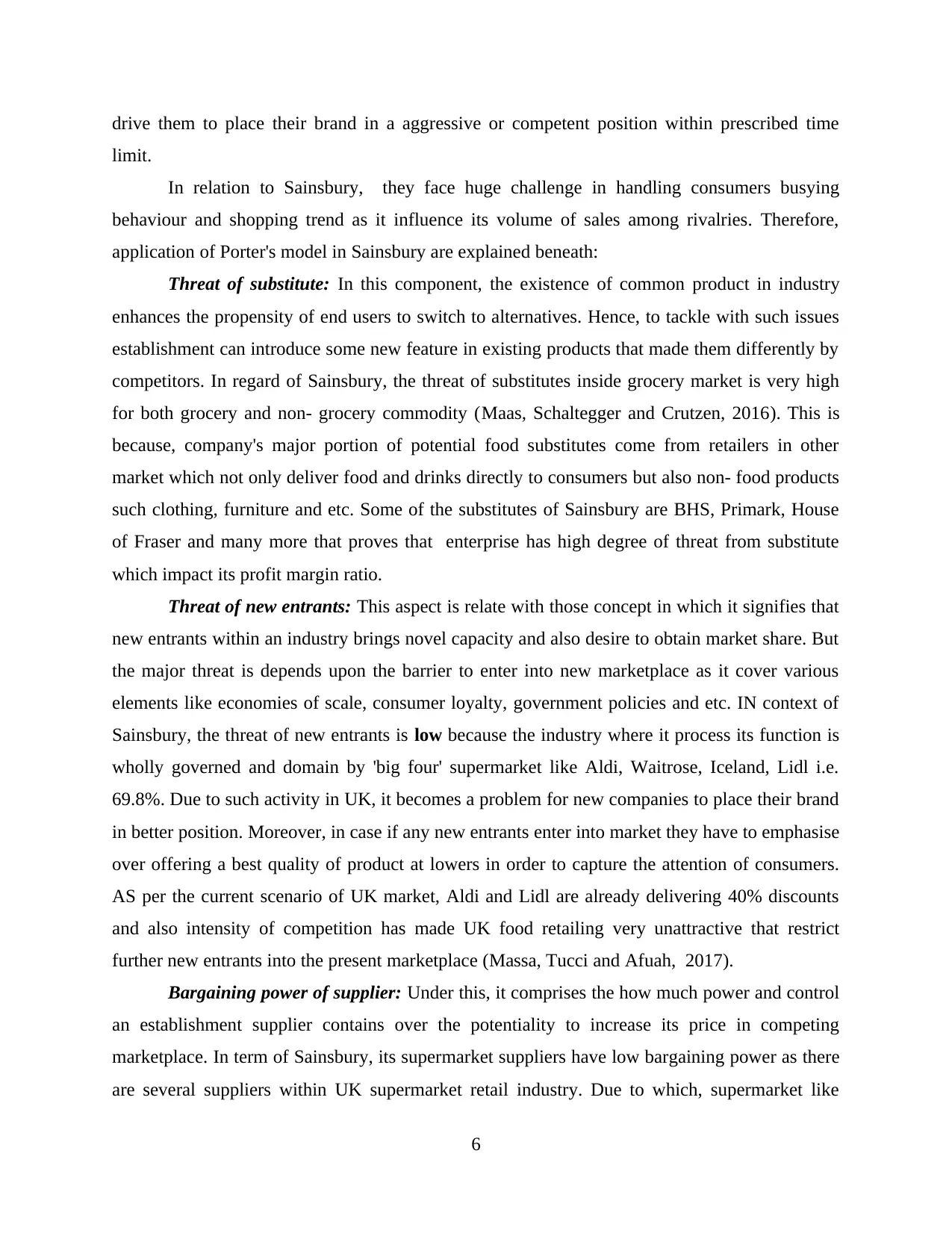
drive them to place their brand in a aggressive or competent position within prescribed time
limit.
In relation to Sainsbury, they face huge challenge in handling consumers busying
behaviour and shopping trend as it influence its volume of sales among rivalries. Therefore,
application of Porter's model in Sainsbury are explained beneath:
Threat of substitute: In this component, the existence of common product in industry
enhances the propensity of end users to switch to alternatives. Hence, to tackle with such issues
establishment can introduce some new feature in existing products that made them differently by
competitors. In regard of Sainsbury, the threat of substitutes inside grocery market is very high
for both grocery and non- grocery commodity (Maas, Schaltegger and Crutzen, 2016). This is
because, company's major portion of potential food substitutes come from retailers in other
market which not only deliver food and drinks directly to consumers but also non- food products
such clothing, furniture and etc. Some of the substitutes of Sainsbury are BHS, Primark, House
of Fraser and many more that proves that enterprise has high degree of threat from substitute
which impact its profit margin ratio.
Threat of new entrants: This aspect is relate with those concept in which it signifies that
new entrants within an industry brings novel capacity and also desire to obtain market share. But
the major threat is depends upon the barrier to enter into new marketplace as it cover various
elements like economies of scale, consumer loyalty, government policies and etc. IN context of
Sainsbury, the threat of new entrants is low because the industry where it process its function is
wholly governed and domain by 'big four' supermarket like Aldi, Waitrose, Iceland, Lidl i.e.
69.8%. Due to such activity in UK, it becomes a problem for new companies to place their brand
in better position. Moreover, in case if any new entrants enter into market they have to emphasise
over offering a best quality of product at lowers in order to capture the attention of consumers.
AS per the current scenario of UK market, Aldi and Lidl are already delivering 40% discounts
and also intensity of competition has made UK food retailing very unattractive that restrict
further new entrants into the present marketplace (Massa, Tucci and Afuah, 2017).
Bargaining power of supplier: Under this, it comprises the how much power and control
an establishment supplier contains over the potentiality to increase its price in competing
marketplace. In term of Sainsbury, its supermarket suppliers have low bargaining power as there
are several suppliers within UK supermarket retail industry. Due to which, supermarket like
6
limit.
In relation to Sainsbury, they face huge challenge in handling consumers busying
behaviour and shopping trend as it influence its volume of sales among rivalries. Therefore,
application of Porter's model in Sainsbury are explained beneath:
Threat of substitute: In this component, the existence of common product in industry
enhances the propensity of end users to switch to alternatives. Hence, to tackle with such issues
establishment can introduce some new feature in existing products that made them differently by
competitors. In regard of Sainsbury, the threat of substitutes inside grocery market is very high
for both grocery and non- grocery commodity (Maas, Schaltegger and Crutzen, 2016). This is
because, company's major portion of potential food substitutes come from retailers in other
market which not only deliver food and drinks directly to consumers but also non- food products
such clothing, furniture and etc. Some of the substitutes of Sainsbury are BHS, Primark, House
of Fraser and many more that proves that enterprise has high degree of threat from substitute
which impact its profit margin ratio.
Threat of new entrants: This aspect is relate with those concept in which it signifies that
new entrants within an industry brings novel capacity and also desire to obtain market share. But
the major threat is depends upon the barrier to enter into new marketplace as it cover various
elements like economies of scale, consumer loyalty, government policies and etc. IN context of
Sainsbury, the threat of new entrants is low because the industry where it process its function is
wholly governed and domain by 'big four' supermarket like Aldi, Waitrose, Iceland, Lidl i.e.
69.8%. Due to such activity in UK, it becomes a problem for new companies to place their brand
in better position. Moreover, in case if any new entrants enter into market they have to emphasise
over offering a best quality of product at lowers in order to capture the attention of consumers.
AS per the current scenario of UK market, Aldi and Lidl are already delivering 40% discounts
and also intensity of competition has made UK food retailing very unattractive that restrict
further new entrants into the present marketplace (Massa, Tucci and Afuah, 2017).
Bargaining power of supplier: Under this, it comprises the how much power and control
an establishment supplier contains over the potentiality to increase its price in competing
marketplace. In term of Sainsbury, its supermarket suppliers have low bargaining power as there
are several suppliers within UK supermarket retail industry. Due to which, supermarket like
6
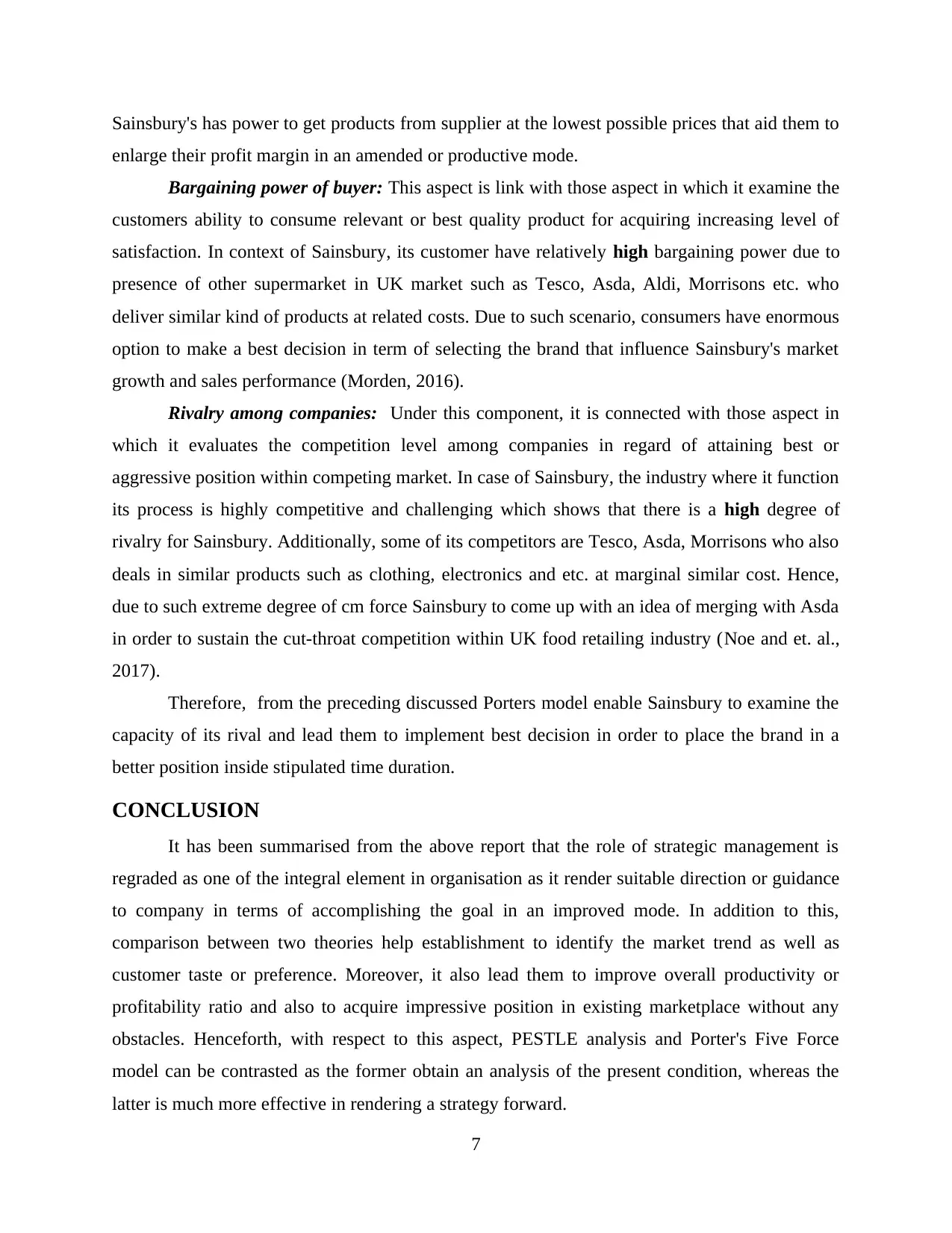
Sainsbury's has power to get products from supplier at the lowest possible prices that aid them to
enlarge their profit margin in an amended or productive mode.
Bargaining power of buyer: This aspect is link with those aspect in which it examine the
customers ability to consume relevant or best quality product for acquiring increasing level of
satisfaction. In context of Sainsbury, its customer have relatively high bargaining power due to
presence of other supermarket in UK market such as Tesco, Asda, Aldi, Morrisons etc. who
deliver similar kind of products at related costs. Due to such scenario, consumers have enormous
option to make a best decision in term of selecting the brand that influence Sainsbury's market
growth and sales performance (Morden, 2016).
Rivalry among companies: Under this component, it is connected with those aspect in
which it evaluates the competition level among companies in regard of attaining best or
aggressive position within competing market. In case of Sainsbury, the industry where it function
its process is highly competitive and challenging which shows that there is a high degree of
rivalry for Sainsbury. Additionally, some of its competitors are Tesco, Asda, Morrisons who also
deals in similar products such as clothing, electronics and etc. at marginal similar cost. Hence,
due to such extreme degree of cm force Sainsbury to come up with an idea of merging with Asda
in order to sustain the cut-throat competition within UK food retailing industry (Noe and et. al.,
2017).
Therefore, from the preceding discussed Porters model enable Sainsbury to examine the
capacity of its rival and lead them to implement best decision in order to place the brand in a
better position inside stipulated time duration.
CONCLUSION
It has been summarised from the above report that the role of strategic management is
regraded as one of the integral element in organisation as it render suitable direction or guidance
to company in terms of accomplishing the goal in an improved mode. In addition to this,
comparison between two theories help establishment to identify the market trend as well as
customer taste or preference. Moreover, it also lead them to improve overall productivity or
profitability ratio and also to acquire impressive position in existing marketplace without any
obstacles. Henceforth, with respect to this aspect, PESTLE analysis and Porter's Five Force
model can be contrasted as the former obtain an analysis of the present condition, whereas the
latter is much more effective in rendering a strategy forward.
7
enlarge their profit margin in an amended or productive mode.
Bargaining power of buyer: This aspect is link with those aspect in which it examine the
customers ability to consume relevant or best quality product for acquiring increasing level of
satisfaction. In context of Sainsbury, its customer have relatively high bargaining power due to
presence of other supermarket in UK market such as Tesco, Asda, Aldi, Morrisons etc. who
deliver similar kind of products at related costs. Due to such scenario, consumers have enormous
option to make a best decision in term of selecting the brand that influence Sainsbury's market
growth and sales performance (Morden, 2016).
Rivalry among companies: Under this component, it is connected with those aspect in
which it evaluates the competition level among companies in regard of attaining best or
aggressive position within competing market. In case of Sainsbury, the industry where it function
its process is highly competitive and challenging which shows that there is a high degree of
rivalry for Sainsbury. Additionally, some of its competitors are Tesco, Asda, Morrisons who also
deals in similar products such as clothing, electronics and etc. at marginal similar cost. Hence,
due to such extreme degree of cm force Sainsbury to come up with an idea of merging with Asda
in order to sustain the cut-throat competition within UK food retailing industry (Noe and et. al.,
2017).
Therefore, from the preceding discussed Porters model enable Sainsbury to examine the
capacity of its rival and lead them to implement best decision in order to place the brand in a
better position inside stipulated time duration.
CONCLUSION
It has been summarised from the above report that the role of strategic management is
regraded as one of the integral element in organisation as it render suitable direction or guidance
to company in terms of accomplishing the goal in an improved mode. In addition to this,
comparison between two theories help establishment to identify the market trend as well as
customer taste or preference. Moreover, it also lead them to improve overall productivity or
profitability ratio and also to acquire impressive position in existing marketplace without any
obstacles. Henceforth, with respect to this aspect, PESTLE analysis and Porter's Five Force
model can be contrasted as the former obtain an analysis of the present condition, whereas the
latter is much more effective in rendering a strategy forward.
7
⊘ This is a preview!⊘
Do you want full access?
Subscribe today to unlock all pages.

Trusted by 1+ million students worldwide
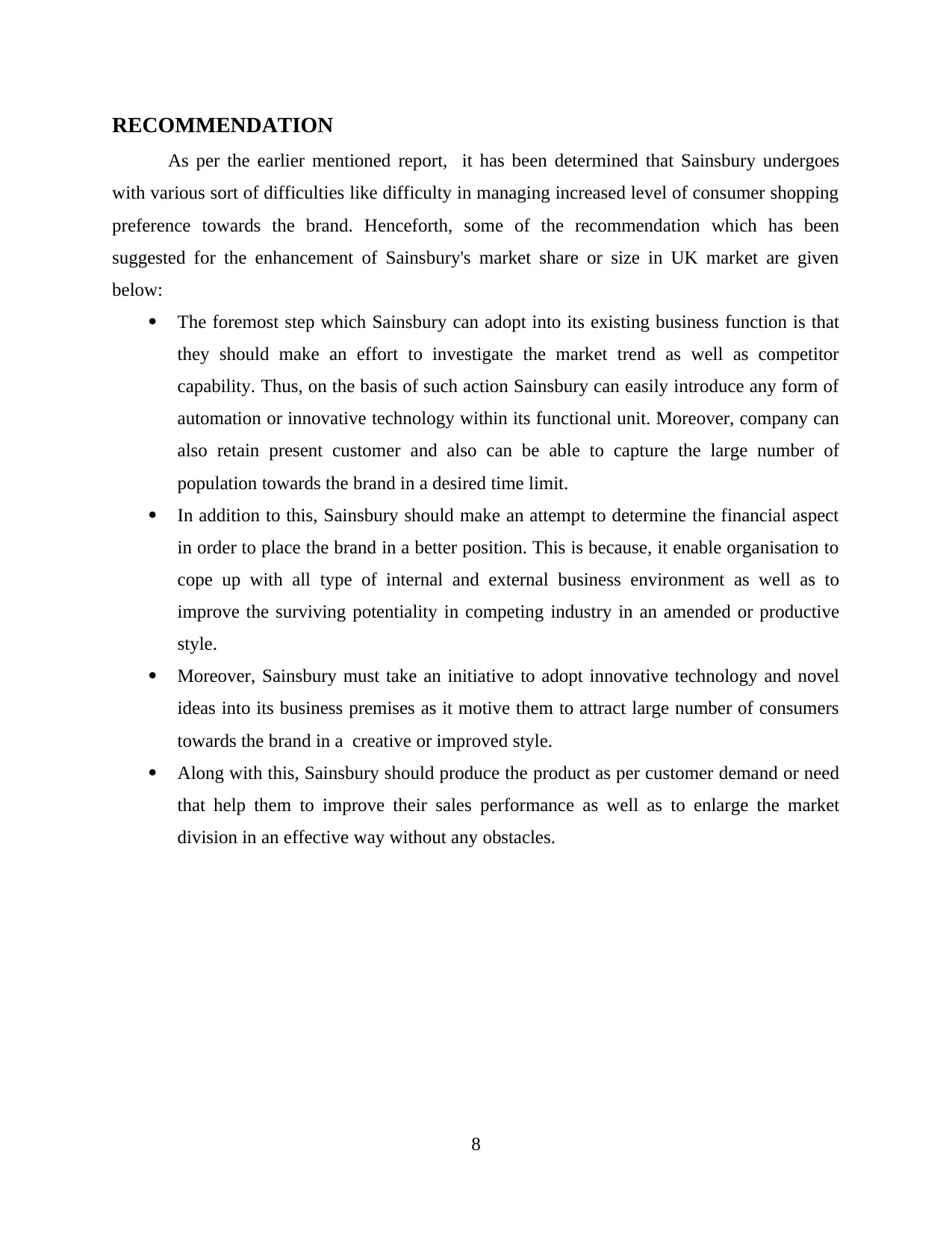
RECOMMENDATION
As per the earlier mentioned report, it has been determined that Sainsbury undergoes
with various sort of difficulties like difficulty in managing increased level of consumer shopping
preference towards the brand. Henceforth, some of the recommendation which has been
suggested for the enhancement of Sainsbury's market share or size in UK market are given
below:
The foremost step which Sainsbury can adopt into its existing business function is that
they should make an effort to investigate the market trend as well as competitor
capability. Thus, on the basis of such action Sainsbury can easily introduce any form of
automation or innovative technology within its functional unit. Moreover, company can
also retain present customer and also can be able to capture the large number of
population towards the brand in a desired time limit.
In addition to this, Sainsbury should make an attempt to determine the financial aspect
in order to place the brand in a better position. This is because, it enable organisation to
cope up with all type of internal and external business environment as well as to
improve the surviving potentiality in competing industry in an amended or productive
style.
Moreover, Sainsbury must take an initiative to adopt innovative technology and novel
ideas into its business premises as it motive them to attract large number of consumers
towards the brand in a creative or improved style.
Along with this, Sainsbury should produce the product as per customer demand or need
that help them to improve their sales performance as well as to enlarge the market
division in an effective way without any obstacles.
8
As per the earlier mentioned report, it has been determined that Sainsbury undergoes
with various sort of difficulties like difficulty in managing increased level of consumer shopping
preference towards the brand. Henceforth, some of the recommendation which has been
suggested for the enhancement of Sainsbury's market share or size in UK market are given
below:
The foremost step which Sainsbury can adopt into its existing business function is that
they should make an effort to investigate the market trend as well as competitor
capability. Thus, on the basis of such action Sainsbury can easily introduce any form of
automation or innovative technology within its functional unit. Moreover, company can
also retain present customer and also can be able to capture the large number of
population towards the brand in a desired time limit.
In addition to this, Sainsbury should make an attempt to determine the financial aspect
in order to place the brand in a better position. This is because, it enable organisation to
cope up with all type of internal and external business environment as well as to
improve the surviving potentiality in competing industry in an amended or productive
style.
Moreover, Sainsbury must take an initiative to adopt innovative technology and novel
ideas into its business premises as it motive them to attract large number of consumers
towards the brand in a creative or improved style.
Along with this, Sainsbury should produce the product as per customer demand or need
that help them to improve their sales performance as well as to enlarge the market
division in an effective way without any obstacles.
8
Paraphrase This Document
Need a fresh take? Get an instant paraphrase of this document with our AI Paraphraser
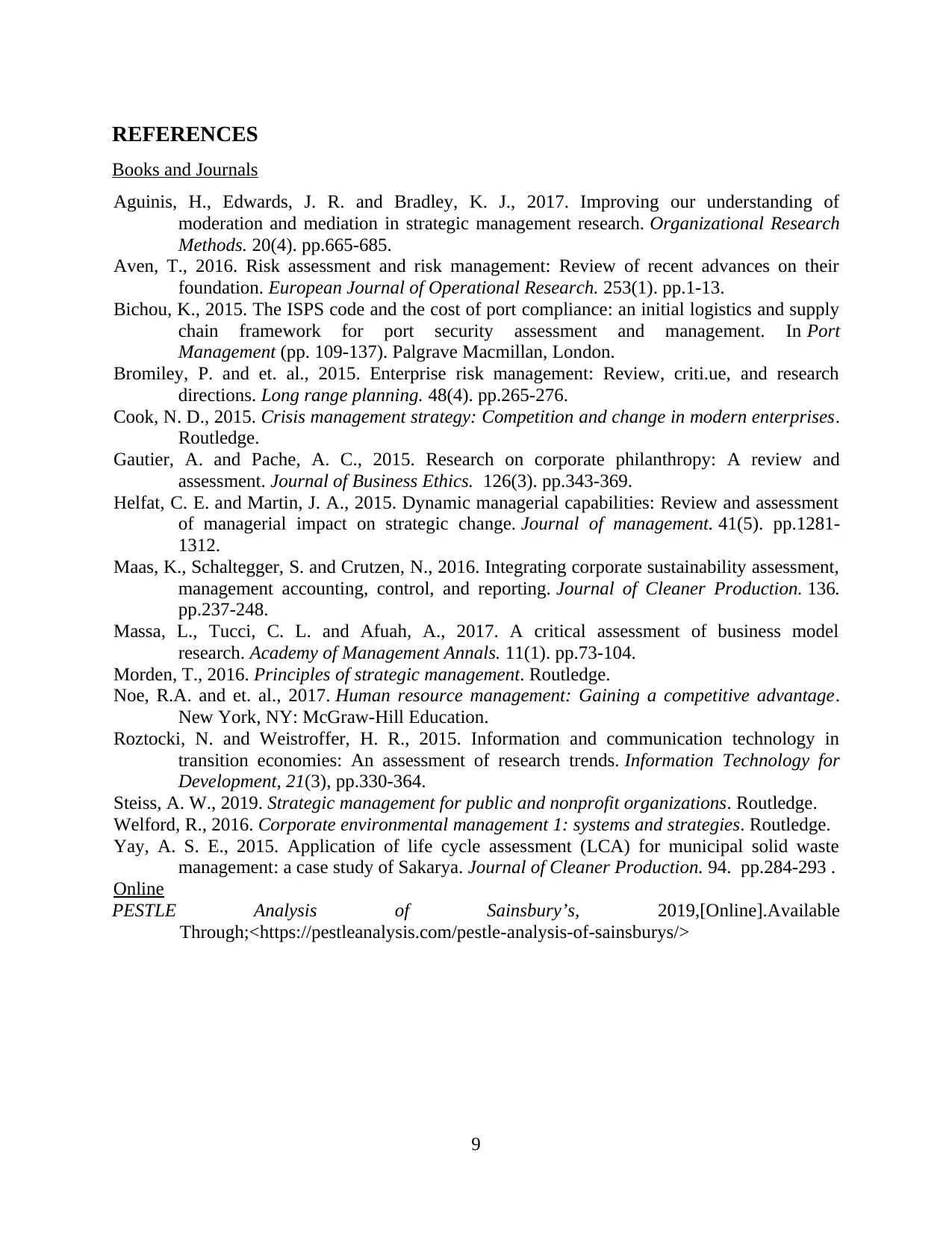
REFERENCES
Books and Journals
Aguinis, H., Edwards, J. R. and Bradley, K. J., 2017. Improving our understanding of
moderation and mediation in strategic management research. Organizational Research
Methods. 20(4). pp.665-685.
Aven, T., 2016. Risk assessment and risk management: Review of recent advances on their
foundation. European Journal of Operational Research. 253(1). pp.1-13.
Bichou, K., 2015. The ISPS code and the cost of port compliance: an initial logistics and supply
chain framework for port security assessment and management. In Port
Management (pp. 109-137). Palgrave Macmillan, London.
Bromiley, P. and et. al., 2015. Enterprise risk management: Review, criti.ue, and research
directions. Long range planning. 48(4). pp.265-276.
Cook, N. D., 2015. Crisis management strategy: Competition and change in modern enterprises.
Routledge.
Gautier, A. and Pache, A. C., 2015. Research on corporate philanthropy: A review and
assessment. Journal of Business Ethics. 126(3). pp.343-369.
Helfat, C. E. and Martin, J. A., 2015. Dynamic managerial capabilities: Review and assessment
of managerial impact on strategic change. Journal of management. 41(5). pp.1281-
1312.
Maas, K., Schaltegger, S. and Crutzen, N., 2016. Integrating corporate sustainability assessment,
management accounting, control, and reporting. Journal of Cleaner Production. 136.
pp.237-248.
Massa, L., Tucci, C. L. and Afuah, A., 2017. A critical assessment of business model
research. Academy of Management Annals. 11(1). pp.73-104.
Morden, T., 2016. Principles of strategic management. Routledge.
Noe, R.A. and et. al., 2017. Human resource management: Gaining a competitive advantage.
New York, NY: McGraw-Hill Education.
Roztocki, N. and Weistroffer, H. R., 2015. Information and communication technology in
transition economies: An assessment of research trends. Information Technology for
Development, 21(3), pp.330-364.
Steiss, A. W., 2019. Strategic management for public and nonprofit organizations. Routledge.
Welford, R., 2016. Corporate environmental management 1: systems and strategies. Routledge.
Yay, A. S. E., 2015. Application of life cycle assessment (LCA) for municipal solid waste
management: a case study of Sakarya. Journal of Cleaner Production. 94. pp.284-293 .
Online
PESTLE Analysis of Sainsbury’s, 2019,[Online].Available
Through;<https://pestleanalysis.com/pestle-analysis-of-sainsburys/>
9
Books and Journals
Aguinis, H., Edwards, J. R. and Bradley, K. J., 2017. Improving our understanding of
moderation and mediation in strategic management research. Organizational Research
Methods. 20(4). pp.665-685.
Aven, T., 2016. Risk assessment and risk management: Review of recent advances on their
foundation. European Journal of Operational Research. 253(1). pp.1-13.
Bichou, K., 2015. The ISPS code and the cost of port compliance: an initial logistics and supply
chain framework for port security assessment and management. In Port
Management (pp. 109-137). Palgrave Macmillan, London.
Bromiley, P. and et. al., 2015. Enterprise risk management: Review, criti.ue, and research
directions. Long range planning. 48(4). pp.265-276.
Cook, N. D., 2015. Crisis management strategy: Competition and change in modern enterprises.
Routledge.
Gautier, A. and Pache, A. C., 2015. Research on corporate philanthropy: A review and
assessment. Journal of Business Ethics. 126(3). pp.343-369.
Helfat, C. E. and Martin, J. A., 2015. Dynamic managerial capabilities: Review and assessment
of managerial impact on strategic change. Journal of management. 41(5). pp.1281-
1312.
Maas, K., Schaltegger, S. and Crutzen, N., 2016. Integrating corporate sustainability assessment,
management accounting, control, and reporting. Journal of Cleaner Production. 136.
pp.237-248.
Massa, L., Tucci, C. L. and Afuah, A., 2017. A critical assessment of business model
research. Academy of Management Annals. 11(1). pp.73-104.
Morden, T., 2016. Principles of strategic management. Routledge.
Noe, R.A. and et. al., 2017. Human resource management: Gaining a competitive advantage.
New York, NY: McGraw-Hill Education.
Roztocki, N. and Weistroffer, H. R., 2015. Information and communication technology in
transition economies: An assessment of research trends. Information Technology for
Development, 21(3), pp.330-364.
Steiss, A. W., 2019. Strategic management for public and nonprofit organizations. Routledge.
Welford, R., 2016. Corporate environmental management 1: systems and strategies. Routledge.
Yay, A. S. E., 2015. Application of life cycle assessment (LCA) for municipal solid waste
management: a case study of Sakarya. Journal of Cleaner Production. 94. pp.284-293 .
Online
PESTLE Analysis of Sainsbury’s, 2019,[Online].Available
Through;<https://pestleanalysis.com/pestle-analysis-of-sainsburys/>
9
1 out of 11
Related Documents
Your All-in-One AI-Powered Toolkit for Academic Success.
+13062052269
info@desklib.com
Available 24*7 on WhatsApp / Email
![[object Object]](/_next/static/media/star-bottom.7253800d.svg)
Unlock your academic potential
Copyright © 2020–2025 A2Z Services. All Rights Reserved. Developed and managed by ZUCOL.




